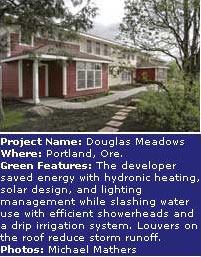According to Proestel, the soil and vegetation not only reduce runoff, but add insulation value. The green roof also protects the roof surface from sunlight and extreme temperatures, giving the apartment building’s roof an estimated 30- or 40-year lifespan—double or triple a conventional roof. While this green roof also costs twice as much (including extra structural support) as a traditional roof, the payoff will come in 15 years, when a conventional roof would have needed replacing.
The project also includes bio-retention landscaping. The grounds were made concave so that the soil could hold and filter runoff before it reaches the bay. The Prince George’s County (Md.) Department of Environmental Resources paid for the landscaping, which it expects to use as a model project.
For energy savings, each of the Mt. Rainier building’s 12 one-bedroom apartments has a tankless hot water heater. “Why heat water all day when you’re not there?” asks Proestel. She estimates that energy savings will pay for the cost of the system in three to five years.
Going Wild
In 1999, Atlanta’s Southface Energy Institute partnered with the Greater Atlanta Homebuilders Association to introduce the EarthCraft House program, a voluntary green building program designed for southern climates. Within five years, though, the initiative had spread beyond single-family homes. By the end of last year, 1,000 units in eight projects—four market-rate and four affordable—were seeking certification. The first multi-family project completed under the program was Magnolia Circle, an 84-unit senior housing development in the Atlanta suburb of Decatur.
Magnolia Circle satisfied the program’s requirements with a tight building envelope, sealed HVAC ducts, Energy Star appliances, low-VOC products, and fresh-air intakes for every apartment. But the project went beyond these requirements. For using indigenous plants that attract local wildlife and other environmentally friendly efforts such as erecting multiple birdhouses, Magnolia Circle became the first apartment complex in Georgia to be recognized as a wildlife preserve. Community gardens, a composting area, and proximity to local transportation earned the community further points on the EarthCraft rating scale.
The developer saw EarthCraft as a great marketing aid, according to Gray Kelly, EarthCraft multifamily program manager. “People associate the EarthCraft label with a better, more durable product,” he says. “The idea is to build something that looks and feels like a normal development but performs much better.”
Selling Sustainable Steve Minn, CFO of Lupe Development in Minneapolis, calls environmental consciousness “part of our branding.” The company’s downtown Stone Arch Apartments, completed in 2003 for $32 million, include 221 loft-style apartments, of which 40 percent are affordable and 60 percent are market-rate.
To attract young buyers, the pair of connected buildings were designed for a warehouse feel, with 10-foot ceilings and 1930s-style bathroom finishes. The project’s green features include energy-saving lighting management. In common areas with lots of windows, lighting controls turn fixtures on only when there’s not enough daylight; in darker interior spaces, lights are controlled by heat and motion detectors. Lights in the parking garage also brighten or dim depending on traffic.
The Minneapolis apartments rented quickly—so quickly, Minn says, that Lupe Development was able to include a conservation-oriented feature that’s usually a hard sell for the convenience-minded: common laundry rooms. But by replacing in-unit washer/dryers with a pair of laundry facilities on each floor of the building, the developer cut water use by 70 percent to 80 percent. To compensate for the inconvenience, each laundry room at Stone Arch Apartments has a lounge with comfortable furniture and modern artwork. Washers and dryers operate on cards that can be loaded by cash or credit card. And residents who wash clothes during off-peak hours (midday and midweek) pay half price.
Tax Smarts Only two states, New York and Maryland, offer a green building tax incentive. The first affordable multifamily project to take advantage of the New York State Green Building Tax Credit was completed earlier this year. Called 1400 on 5th, it now houses 129 middle-income families in the heart of Harlem in New York City. The units were sold as condominiums, and the $1.8 million tax credit passed along savings to the homeowners.
